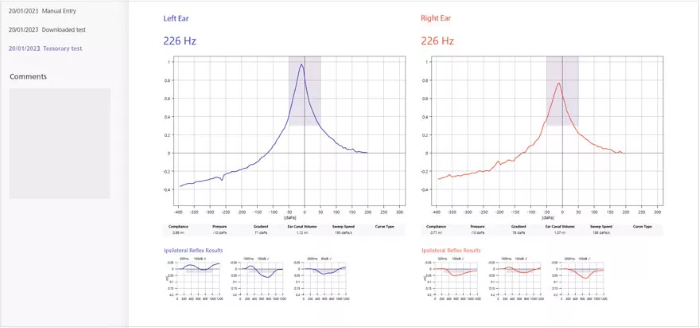Sponsored Content by AmplivoxReviewed by Maria OsipovaFeb 10 2025
A tympanogram is the result of conducting tympanometry, presented as a graphical representation of middle ear compliance relative to air pressure. It is typically produced using a tympanometer, a specialized instrument designed to evaluate the condition of the middle ear.

Image Credit: Amplivox
They are helpful in the fields of audiology and otolaryngology as they can verify middle ear function and aid in the diagnosis of issues like ear infections or problems arising with the eustachian tube.
Interpreting a tympanogram requires expertise and is best performed by audiologists, ear, nose and throat specialists, otolaryngologists, or other qualified healthcare professionals. These experts analyze tympanogram results in conjunction with other diagnostic tests to determine the most appropriate course of treatment for the patient.
How to interpret a tympanogram
Understanding a tympanogram involves interpretation of the graph produced by a tympanometry test.
Source: Amplivox
| X-Axis |
Y-Axis |
| Air pressure is typically represented on the horizontal (X) axis. The range of air pressure tested is usually from -400 to +200 daPa (decaPascals). |
Compliance (or admittance) is represented on the vertical (Y) axis. Compliance is a measure of how much the eardrum and the middle ear system move in response to changes in air pressure. Usually, we measure it in milliliters or cubic centimeters (ml or cm3). |
Tympanogram types
There are several types of tympanograms, each reflecting different conditions of the middle ear. According to Jerger's classification (1970), the most common types are Type A, Type B, and Type C.1
In recent years, additional variations have been introduced to better describe and differentiate specific middle ear disorders, reflecting advancements in diagnostic approaches.
The frequency used during the test significantly influences the interpretation of the results. Tympanometry curves plot eardrum compliance as a function of the pressure applied to the ear canal, providing valuable insights into middle ear health.
Source: Amplivox
Other parameters should also be assessed alongside the test compliance curve. Examples of these include the maximum compliance curve values (air pressure in daPa and compliance value in ml), the curve’s width, also known as the gradient (in daPa) and the volume of the ear canal (measured in ml).
The ear canal volume (ECV) is especially important, as it can be utilized to distinguish between a perforated eardrum (high volume) and an otitis media (regular volume).
Evaluate the characteristics
Alongside the type, other tympanogram properties can deliver valuable data in terms of interpreting results:
- Peak height: The compliance peak’s height suggests the degree of middle ear compliance.
- Peak pressure: Peak compliance pressure is key for identifying diseases, including eustachian tube dysfunction.
Normative data
Tympanograms often include a normative area on the graph, typically represented as a rectangle. For a tympanogram to be classified as "normal" (Type A), its peak should fall within this area. This visual cue simplifies interpretation, as it allows practitioners to quickly assess whether the peak is within the acceptable range.
It’s important to refer to practice guidelines and recommendations from your local or national authority to ensure you are using the appropriate normative values when evaluating tympanometry results.
Correlate with clinical data
Tympanograms are just one piece of the puzzle in assessing middle ear function. To diagnose or understand the tympanogram, it is important to consider the patient's medical history, audiometry, and symptoms.
Industry-leading tympanometers
Amplivox offers industry-leading handheld and desktop tympanometers designed to deliver fast and accurate middle ear measurements for all age groups, including neonates.
With large LCD displays, users can view test progress and diagnostic results in real-time during and after the automatic test, making interpretation straightforward. The data can also be processed efficiently to support high-quality customer care.
These tympanometers also feature single-click integration with third-party Electronic Medical Record (EMR) systems, including Noah, Auditbase, and OtoAccess®. This seamless connectivity ensures efficient data transfer, streamlining workflows and enhancing overall productivity.
References and further reading
- American Speech-Language-Hearing Association. ASHA Practice Policy. [online] Available at: https://www.asha.org/policy.
About Amplivox
Amplivox creates a healthier future by providing accessible and accurate medical solutions for everyone.
As a manufacturer with more than 90 years of experience, we are proud to be a trusted partner to hearing and occupational health professionals all over the world by delivering a high level of knowledge-led solutions, service and support. We are here to be your preferred audiological and occupational health equipment provider.
Sponsored Content Policy: News-Medical.net publishes articles and related content that may be derived from sources where we have existing commercial relationships, provided such content adds value to the core editorial ethos of News-Medical.Net which is to educate and inform site visitors interested in medical research, science, medical devices and treatments.